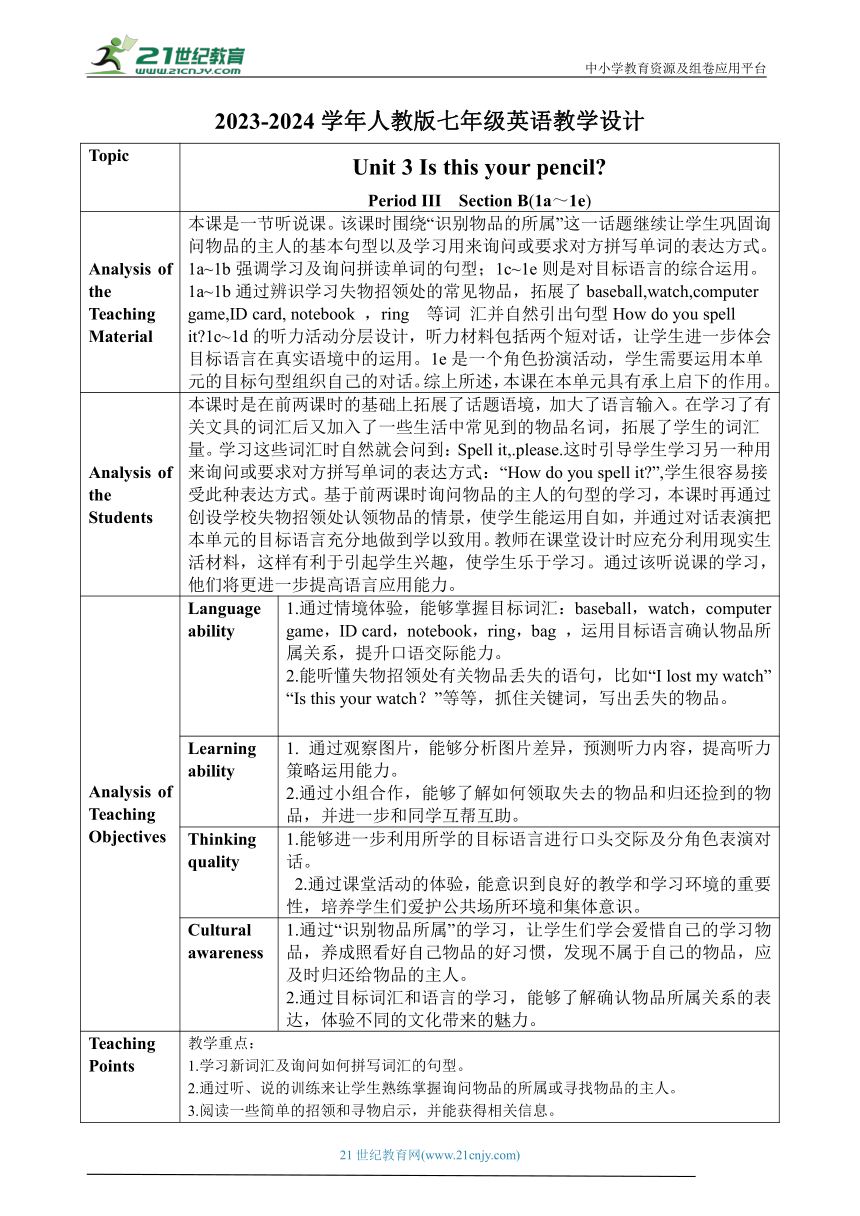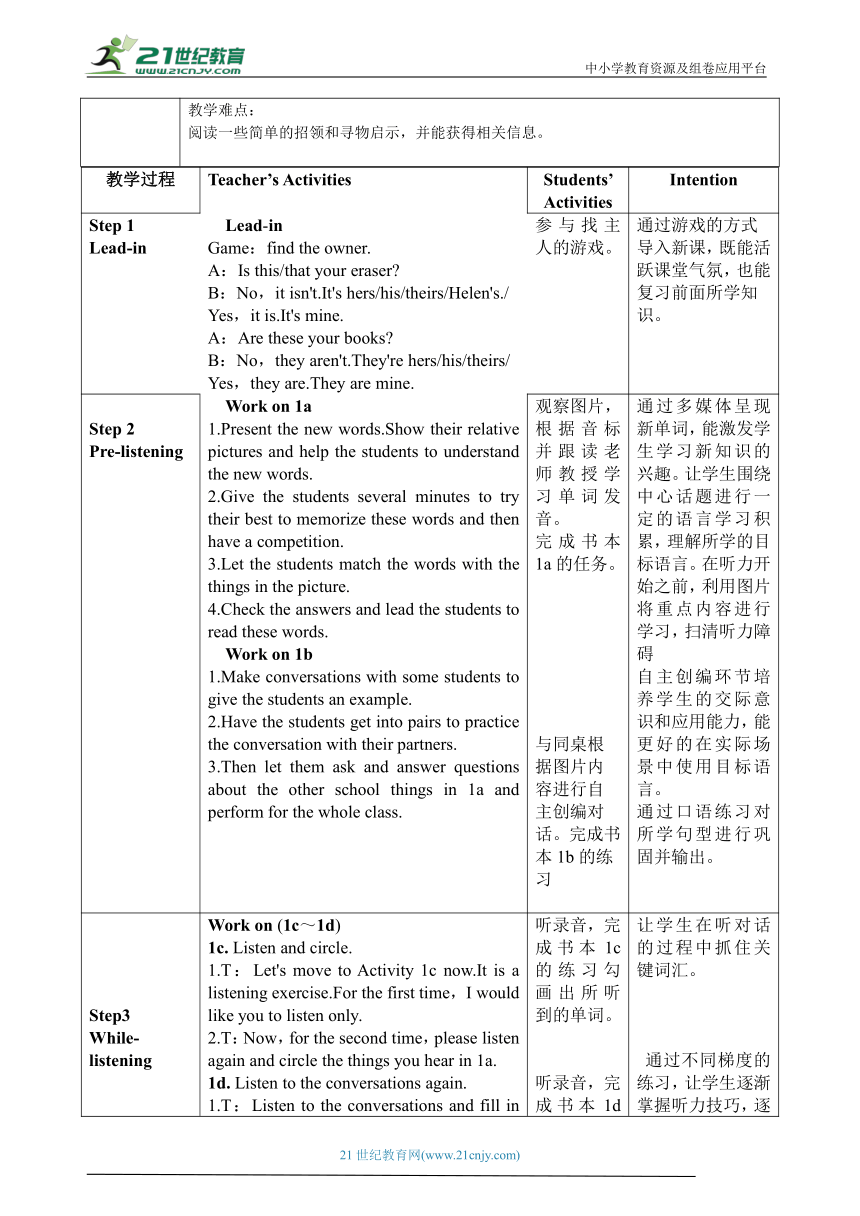【核心素养目标】Unit 3 Section B(1a~1e) 表格式教学设计 人教版英语七年级上册Unit 3 Is this your pencil?
文档属性
| 名称 | 【核心素养目标】Unit 3 Section B(1a~1e) 表格式教学设计 人教版英语七年级上册Unit 3 Is this your pencil? |  | |
| 格式 | doc | ||
| 文件大小 | 204.7KB | ||
| 资源类型 | 试卷 | ||
| 版本资源 | 人教新目标(Go for it)版 | ||
| 科目 | 英语 | ||
| 更新时间 | 2023-10-04 16:39:15 | ||
图片预览


文档简介
中小学教育资源及组卷应用平台
2023-2024学年人教版七年级英语教学设计
Topic Unit 3 Is this your pencil Period III Section B(1a~1e)
Analysis of the Teaching Material 本课是一节听说课。该课时围绕“识别物品的所属”这一话题继续让学生巩固询问物品的主人的基本句型以及学习用来询问或要求对方拼写单词的表达方式。1a~1b强调学习及询问拼读单词的句型;1c~1e则是对目标语言的综合运用。1a~1b通过辨识学习失物招领处的常见物品,拓展了baseball,watch,computer game,ID card, notebook ,ring 等词
汇并自然引出句型How do you spell it 1c~1d的听力活动分层设计,听力材料包括两个短对话,让学生进一步体会目标语言在真实语境中的运用。1e是一个角色扮演活动,学生需要运用本单元的目标句型组织自己的对话。综上所述,本课在本单元具有承上启下的作用。
Analysis of the Students 本课时是在前两课时的基础上拓展了话题语境,加大了语言输入。在学习了有关文具的词汇后又加入了一些生活中常见到的物品名词,拓展了学生的词汇量。学习这些词汇时自然就会问到:Spell it,.please.这时引导学生学习另一种用来询问或要求对方拼写单词的表达方式:“How do you spell it ”,学生很容易接受此种表达方式。基于前两课时询问物品的主人的句型的学习,本课时再通过创设学校失物招领处认领物品的情景,使学生能运用自如,并通过对话表演把本单元的目标语言充分地做到学以致用。教师在课堂设计时应充分利用现实生活材料,这样有利于引起学生兴趣,使学生乐于学习。通过该听说课的学习,他们将更进一步提高语言应用能力。
Analysis of Teaching Objectives Language ability 1.通过情境体验,能够掌握目标词汇:baseball,watch,computer game,ID card,notebook,ring,bag ,运用目标语言确认物品所属关系,提升口语交际能力。
2.能听懂失物招领处有关物品丢失的语句,比如“I lost my watch” “Is this your watch?”等等,抓住关键词,写出丢失的物品。
Learningability 通过观察图片,能够分析图片差异,预测听力内容,提高听力策略运用能力。
2.通过小组合作,能够了解如何领取失去的物品和归还捡到的物品,并进一步和同学互帮互助。
Thinking quality 1.能够进一步利用所学的目标语言进行口头交际及分角色表演对话。
2.通过课堂活动的体验,能意识到良好的教学和学习环境的重要性,培养学生们爱护公共场所环境和集体意识。
Cultural awareness 1.通过“识别物品所属”的学习,让学生们学会爱惜自己的学习物品,养成照看好自己物品的好习惯,发现不属于自己的物品,应及时归还给物品的主人。2.通过目标词汇和语言的学习,能够了解确认物品所属关系的表达,体验不同的文化带来的魅力。
Teaching Points 教学重点:1.学习新词汇及询问如何拼写词汇的句型。2.通过听、说的训练来让学生熟练掌握询问物品的所属或寻找物品的主人。3.阅读一些简单的招领和寻物启示,并能获得相关信息。教学难点:阅读一些简单的招领和寻物启示,并能获得相关信息。
教学过程 Teacher’s Activities Students’ Activities Intention
Step 1Lead-in Lead-inGame:find the owner.A:Is this/that your eraser B:No,it isn't.It's hers/his/theirs/Helen's./Yes,it is.It's mine.A:Are these your books B:No,they aren't.They're hers/his/theirs/Yes,they are.They are mine. 参与找主人的游戏。 通过游戏的方式导入新课,既能活跃课堂气氛,也能复习前面所学知识。
Step 2Pre-listening Work on 1a1.Present the new words.Show their relative pictures and help the students to understand the new words.2.Give the students several minutes to try their best to memorize these words and then have a competition.3.Let the students match the words with the things in the picture.4.Check the answers and lead the students to read these words. Work on 1b1.Make conversations with some students to give the students an example.2.Have the students get into pairs to practice the conversation with their partners.3.Then let them ask and answer questions about the other school things in 1a and perform for the whole class. 观察图片,根据音标并跟读老师教授学习单词发音。完成书本1a的任务。与同桌根据图片内容进行自主创编对话。完成书本1b的练习 通过多媒体呈现新单词,能激发学生学习新知识的兴趣。让学生围绕中心话题进行一定的语言学习积累,理解所学的目标语言。在听力开始之前,利用图片将重点内容进行学习,扫清听力障碍自主创编环节培养学生的交际意识和应用能力,能更好的在实际场景中使用目标语言。通过口语练习对所学句型进行巩固并输出。
Step3While-listening Work on (1c~1d)1c. Listen and circle.1.T:Let's move to Activity 1c now.It is a listening exercise.For the first time,I would like you to listen only.2.T:Now,for the second time,please listen again and circle the things you hear in 1a.1d. Listen to the conversations again.1.T:Listen to the conversations and fill in the chart.2.T:Listen to the conversations and check the answers by yourselves. 听录音,完成书本1c的练习勾画出所听到的单词。听录音,完成书本1d的练习找出属于Linda或Mike的物品。 让学生在听对话的过程中抓住关键词汇。 通过不同梯度的练习,让学生逐渐掌握听力技巧,逐步提高听说能力。
Step4Post-listening Step 5 Work on 1e1.listen to the recording and repeat.2.Let the students work in pairs and make conversations about the things in 1d.(One student acts as Linda and his/her partner acts as Mike.) 3.Then make them change roles and make another conversation and practice it. 跟读录音,与同桌角色表演对话。 跟读录音并进行角色扮演的活动都有利于学生对课本内容快速熟悉并掌握,了解其在具体语境中的应用。进行语言实践,鼓励学生大胆开口,巩固所学的功能句型。
Step 5Language Points Explanation T explains knowledge points. How do you spell it 你怎样拼读它 how疑问词, 意为“怎么; 怎样”, 引导特殊疑问句。do为助动词, 用来帮助实义动词spell构成特殊疑问句。(1)how还可以用来表示程度、询问人的感觉或身体状况、引导感叹句等。 How is your mother 你妈妈怎么样 How clever he is! 他真聪明! (2)用于询问单词的拼写方式。How do you spell it 你怎样拼写它?(3)用于询问交通方式。 How do you go to school every day 你每天怎么上学?(4)和一些形容词连用构成特殊疑问短语。 how old; how often; how long; how far; how many; how much; (5)用于构成感叹句“how+形容词或副词”开头。 How interesting the book is!这本书真有意思! 将知识点做好笔记。 将本课重点汇总系统的进行讲解和分析,结合典例,帮助学生形成语言体系。
Step6Exercises 单项选择1. —What’s this —It’s ID card. A. a B. an C. the D. /2. —What’s that — a computer game. A. It B. It’s C. That D. That’s3.—Is this his red pen —No, it isn’t. The blue pen is . A. he B. him C. his D. hers4. —Are those your —Yes, they are. A. bags B. bag C. watch D. ID card5. — do you spell your name —B-O-B. A. What B. How C. Who D. What color 让学生在课上练习消化知识点,及时操练重点知识点和目标语言,让教师把握学情。
Step 7Summary Summarize the key content in this lesson. 跟随老师一起进行内容总结。 强化巩固本课所学内容。
Step 8 Homework 1.Recite the new words in 1a.2.Make a conversation according to 1b. 将家庭作业做好记录。 检查学习效果,加深对知识的理解和记忆。
Blackboard Design Unit 3 Is this your pencil Period III Section B(1a~1e)New words:baseball,watch,computer gameID card,notebook,ring,bag Sentences:—What's this —It's a watch.—How do you spell it —W-A-T-C-H.
Teaching Reflection: 亮点
1.在听说课中注重了语音教学;在听力训练活动中注重了学法指导。2.这次的课堂教学设计能体现目标与教学过程的一致性。课堂小结中提供给学生根据语义场记忆单词的策略。
有待改进 1.导入和呈现环节用时较多。
2.教学过程中常给学生留出充足的听说训练的机会,这样有时会导致教学环节处理不完整。
21世纪教育网 www.21cnjy.com 精品试卷·第 2 页 (共 2 页)
HYPERLINK "http://www.21cnjy.com/" 21世纪教育网(www.21cnjy.com)
2023-2024学年人教版七年级英语教学设计
Topic Unit 3 Is this your pencil Period III Section B(1a~1e)
Analysis of the Teaching Material 本课是一节听说课。该课时围绕“识别物品的所属”这一话题继续让学生巩固询问物品的主人的基本句型以及学习用来询问或要求对方拼写单词的表达方式。1a~1b强调学习及询问拼读单词的句型;1c~1e则是对目标语言的综合运用。1a~1b通过辨识学习失物招领处的常见物品,拓展了baseball,watch,computer game,ID card, notebook ,ring 等词
汇并自然引出句型How do you spell it 1c~1d的听力活动分层设计,听力材料包括两个短对话,让学生进一步体会目标语言在真实语境中的运用。1e是一个角色扮演活动,学生需要运用本单元的目标句型组织自己的对话。综上所述,本课在本单元具有承上启下的作用。
Analysis of the Students 本课时是在前两课时的基础上拓展了话题语境,加大了语言输入。在学习了有关文具的词汇后又加入了一些生活中常见到的物品名词,拓展了学生的词汇量。学习这些词汇时自然就会问到:Spell it,.please.这时引导学生学习另一种用来询问或要求对方拼写单词的表达方式:“How do you spell it ”,学生很容易接受此种表达方式。基于前两课时询问物品的主人的句型的学习,本课时再通过创设学校失物招领处认领物品的情景,使学生能运用自如,并通过对话表演把本单元的目标语言充分地做到学以致用。教师在课堂设计时应充分利用现实生活材料,这样有利于引起学生兴趣,使学生乐于学习。通过该听说课的学习,他们将更进一步提高语言应用能力。
Analysis of Teaching Objectives Language ability 1.通过情境体验,能够掌握目标词汇:baseball,watch,computer game,ID card,notebook,ring,bag ,运用目标语言确认物品所属关系,提升口语交际能力。
2.能听懂失物招领处有关物品丢失的语句,比如“I lost my watch” “Is this your watch?”等等,抓住关键词,写出丢失的物品。
Learningability 通过观察图片,能够分析图片差异,预测听力内容,提高听力策略运用能力。
2.通过小组合作,能够了解如何领取失去的物品和归还捡到的物品,并进一步和同学互帮互助。
Thinking quality 1.能够进一步利用所学的目标语言进行口头交际及分角色表演对话。
2.通过课堂活动的体验,能意识到良好的教学和学习环境的重要性,培养学生们爱护公共场所环境和集体意识。
Cultural awareness 1.通过“识别物品所属”的学习,让学生们学会爱惜自己的学习物品,养成照看好自己物品的好习惯,发现不属于自己的物品,应及时归还给物品的主人。2.通过目标词汇和语言的学习,能够了解确认物品所属关系的表达,体验不同的文化带来的魅力。
Teaching Points 教学重点:1.学习新词汇及询问如何拼写词汇的句型。2.通过听、说的训练来让学生熟练掌握询问物品的所属或寻找物品的主人。3.阅读一些简单的招领和寻物启示,并能获得相关信息。教学难点:阅读一些简单的招领和寻物启示,并能获得相关信息。
教学过程 Teacher’s Activities Students’ Activities Intention
Step 1Lead-in Lead-inGame:find the owner.A:Is this/that your eraser B:No,it isn't.It's hers/his/theirs/Helen's./Yes,it is.It's mine.A:Are these your books B:No,they aren't.They're hers/his/theirs/Yes,they are.They are mine. 参与找主人的游戏。 通过游戏的方式导入新课,既能活跃课堂气氛,也能复习前面所学知识。
Step 2Pre-listening Work on 1a1.Present the new words.Show their relative pictures and help the students to understand the new words.2.Give the students several minutes to try their best to memorize these words and then have a competition.3.Let the students match the words with the things in the picture.4.Check the answers and lead the students to read these words. Work on 1b1.Make conversations with some students to give the students an example.2.Have the students get into pairs to practice the conversation with their partners.3.Then let them ask and answer questions about the other school things in 1a and perform for the whole class. 观察图片,根据音标并跟读老师教授学习单词发音。完成书本1a的任务。与同桌根据图片内容进行自主创编对话。完成书本1b的练习 通过多媒体呈现新单词,能激发学生学习新知识的兴趣。让学生围绕中心话题进行一定的语言学习积累,理解所学的目标语言。在听力开始之前,利用图片将重点内容进行学习,扫清听力障碍自主创编环节培养学生的交际意识和应用能力,能更好的在实际场景中使用目标语言。通过口语练习对所学句型进行巩固并输出。
Step3While-listening Work on (1c~1d)1c. Listen and circle.1.T:Let's move to Activity 1c now.It is a listening exercise.For the first time,I would like you to listen only.2.T:Now,for the second time,please listen again and circle the things you hear in 1a.1d. Listen to the conversations again.1.T:Listen to the conversations and fill in the chart.2.T:Listen to the conversations and check the answers by yourselves. 听录音,完成书本1c的练习勾画出所听到的单词。听录音,完成书本1d的练习找出属于Linda或Mike的物品。 让学生在听对话的过程中抓住关键词汇。 通过不同梯度的练习,让学生逐渐掌握听力技巧,逐步提高听说能力。
Step4Post-listening Step 5 Work on 1e1.listen to the recording and repeat.2.Let the students work in pairs and make conversations about the things in 1d.(One student acts as Linda and his/her partner acts as Mike.) 3.Then make them change roles and make another conversation and practice it. 跟读录音,与同桌角色表演对话。 跟读录音并进行角色扮演的活动都有利于学生对课本内容快速熟悉并掌握,了解其在具体语境中的应用。进行语言实践,鼓励学生大胆开口,巩固所学的功能句型。
Step 5Language Points Explanation T explains knowledge points. How do you spell it 你怎样拼读它 how疑问词, 意为“怎么; 怎样”, 引导特殊疑问句。do为助动词, 用来帮助实义动词spell构成特殊疑问句。(1)how还可以用来表示程度、询问人的感觉或身体状况、引导感叹句等。 How is your mother 你妈妈怎么样 How clever he is! 他真聪明! (2)用于询问单词的拼写方式。How do you spell it 你怎样拼写它?(3)用于询问交通方式。 How do you go to school every day 你每天怎么上学?(4)和一些形容词连用构成特殊疑问短语。 how old; how often; how long; how far; how many; how much; (5)用于构成感叹句“how+形容词或副词”开头。 How interesting the book is!这本书真有意思! 将知识点做好笔记。 将本课重点汇总系统的进行讲解和分析,结合典例,帮助学生形成语言体系。
Step6Exercises 单项选择1. —What’s this —It’s ID card. A. a B. an C. the D. /2. —What’s that — a computer game. A. It B. It’s C. That D. That’s3.—Is this his red pen —No, it isn’t. The blue pen is . A. he B. him C. his D. hers4. —Are those your —Yes, they are. A. bags B. bag C. watch D. ID card5. — do you spell your name —B-O-B. A. What B. How C. Who D. What color 让学生在课上练习消化知识点,及时操练重点知识点和目标语言,让教师把握学情。
Step 7Summary Summarize the key content in this lesson. 跟随老师一起进行内容总结。 强化巩固本课所学内容。
Step 8 Homework 1.Recite the new words in 1a.2.Make a conversation according to 1b. 将家庭作业做好记录。 检查学习效果,加深对知识的理解和记忆。
Blackboard Design Unit 3 Is this your pencil Period III Section B(1a~1e)New words:baseball,watch,computer gameID card,notebook,ring,bag Sentences:—What's this —It's a watch.—How do you spell it —W-A-T-C-H.
Teaching Reflection: 亮点
1.在听说课中注重了语音教学;在听力训练活动中注重了学法指导。2.这次的课堂教学设计能体现目标与教学过程的一致性。课堂小结中提供给学生根据语义场记忆单词的策略。
有待改进 1.导入和呈现环节用时较多。
2.教学过程中常给学生留出充足的听说训练的机会,这样有时会导致教学环节处理不完整。
21世纪教育网 www.21cnjy.com 精品试卷·第 2 页 (共 2 页)
HYPERLINK "http://www.21cnjy.com/" 21世纪教育网(www.21cnjy.com)
同课章节目录
- starters 预备篇(2012秋审查)
- Unit 1 Good morning !
- Unit 2 What’s this in English?
- Unit 3 What color is it ?
- Unit 1 My name's Gina.
- Section A
- Section B
- Unit 2 This is my sister.
- Section A
- Section B
- Unit 3 Is this your pencil?
- Section A
- Section B
- Unit 4 Where's my schoolbag?
- Section A
- Section B
- Unit 5 Do you have a soccer ball?
- Section A
- Section B
- Unit 6 Do you like bananas?
- Section A
- Section B
- Unit 7 How much are these socks?
- Section A
- Section B
- Unit 8 When is your birthday?
- Section A
- Section B
- Unit 9 My favorite subject is science.
- Section A
- Section B
